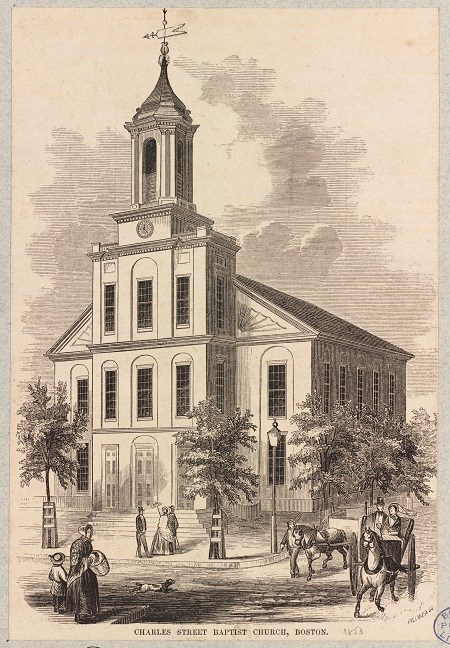
Boston Public Library A pillar in Boston's Black community, Charles Street Meeting House once occupied the building on the corner of today's Charles Street and Mt. Vernon Street. Built in 1807, this building originally housed the Third Baptist Church.1 The segregationist tradition of New England church seating patterns prevailed here. In April 1836, member Timothy Gilbert, later an active financial supporter of the Boston Vigilance Committee, tested the church's racial segregation policy by inviting several African Americans to join him in his pew. The church immediately expelled Gilbert for this violation. He soon set out with several other members to form the First Free Baptist Church. Officially recognized in 1839, this church eventually became Tremont Temple, the first church in Boston to abolish pew rental fees. Considered "the first integrated church in America," Tremont Temple declared that "'all who practice slavery or justify it shall be excluded from the church and its communion.'"2 Though a 1937 article in the Boston Globe reported that Frederick Douglass, Sojourner Truth, and other abolitionist luminaries spoke from the pulpit of Third Baptist Church, further research is needed and ongoing to verify these claims.3 In 1876, the First African Methodist Episcopal (AME) congregation, previously located on today's Anderson Street, purchased the Charles Street Meetinghouse for forty thousand dollars.4 In 1916, AME historian Richard R. Wright wrote: In the early history of this church the Negroes of Boston were only allowed to occupy the first two rows in the gallery on the Charles Street side during the services…Now they own the building.5 In addition to religious services, the Charles Street Meeting House served as a forum and gathering place for local activists. For example, on the final day of the 1895 First National Conference of Colored Women of America, Josephine St. Pierre Ruffin and other local Black clubwomen organized a special session at Charles Street A.M.E. Church. Here, delegates from across the United States agreed to form the National Federation of Afro-American Women, one of the precursors to the National Association of Colored Women's Clubs.6 The AME congregation held services in this location until 1939, even after many of its members had moved to the South End of Boston. It became the last Black institution to leave Beacon Hill. Still called the Charles Street AME Church, it is now located at 551 Warren Street. Footnotes:
|
Last updated: December 11, 2024
